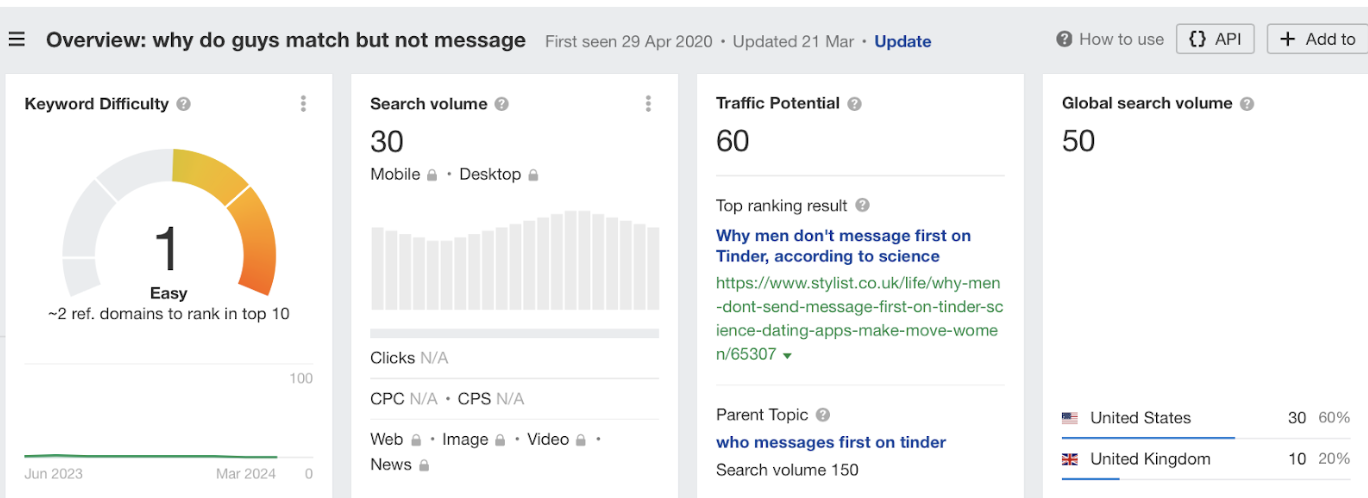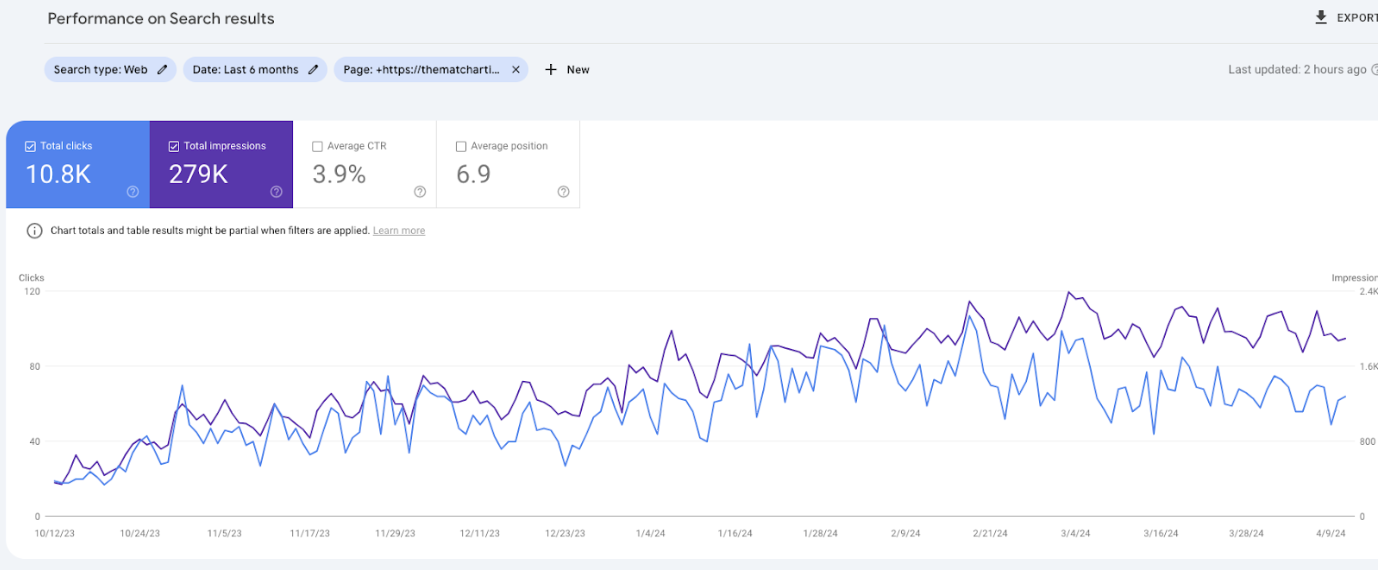Our recent LinkedIn post showcasing a client success story generated so much buzz that it inspired us to create a detailed case study.
Before I get into the finer details, here’s an overview.
The Match Artist had a goal on its 2023 vision board to get 10,000 unique monthly visitors.

But there was an obvious challenge: it was playing in an oversaturated and fiercely competitive online dating market.
Our initial audit revealed several problems on the website, including the absence of structured content silos and the lack of a robust content strategy. Based on this insight, we crafted a strategic pivot that could set The Match Artist apart from its competitors.
The crux of our strategy was focusing on niche, app-specific queries around popular dating apps — many of which showed zero search volume on tools like Ahrefs and Keywords Everywhere. We gathered all the prevalent questions users had about popular dating apps such as Bumble, Hinge, and Tinder and developed targeted content silos to address these queries directly.
Today, The Match Artist enjoys over 1,700 daily clicks, significantly enhanced engagement, and an uptick in bookings.
This case study details every step of our strategic journey, from initial audits to keyword research and the content strategy tactics that generated over 100,000 clicks in just six months. Keep reading to find out how we achieved these impressive results.

1. Customer Personas and Search Journey Analysis
We needed to understand the client’s unique target audience to create a successful SEO strategy. Our research showed the following audience demographics:
- Young Men Seeking Women Their Age: often struggling with standing out in a competitive digital dating scene.
- Below Average Looking Men: seeking ways to improve their appeal through better profile pictures.
- Older Women Seeking Men: looking for high-quality photos that reflect their vibrancy and appeal.
- Anyone Not Seeing Results: frustrated with their current lack of success on dating platforms.
Next, we dug into each persona. We researched the typical online behaviors of these groups, focusing on their interactions with popular dating apps like Bumble, Tinder, and Hinge. Our goal was to pinpoint exactly what these users were searching for and the challenges they faced seeking meaningful connections.
Common pain points included:
- Low Match Rates: many were not matching with people they were genuinely interested in.
- Presentation Issues: uncertainty about how to present themselves effectively in their profiles
- Photo Ineffectiveness: concerns over why their current profile photos were not yielding results
These pain points formed the bedrock of our content strategy.
2. Topic Research — The Creative Approach
Next, we dug into our target audience’s recurring questions about leading dating apps like Bumble, Hinge, Dil Mil, and Tinder via these channels:
People Also Ask
We tapped into this valuable resource to gather commonly asked questions by users. For example, a simple search for “Bumble” and “Bumble dating tips” provided a wealth of seed questions that informed our content development.

Zero Search Volume and Strategic Thinking
We wanted to go beyond the traditional keyword research strategy using commonly available tools and follow the ZSV (Zero Search Volume) approach. This methodology focuses on queries that typically do not appear in popular keyword research tools like Ahrefs or SEMrush due to their perceived low search activity. However, these are precisely the questions real users are asking.
ZSV keywords can register as having “zero” or “very low” search volume, but they often reflect genuine customer inquiries that are overlooked by traditional SEO metrics. I’ll quickly go over some of the tactics we employed to find ZSV keywords. If you’re keen, this note from Steve on SEONotebook talks about finding ZSV keywords in detail.
Approach 1: Find topic ideas in forums and online discussions.
We started by exploring various dating-related online communities, including Facebook groups, Quora, Reddit, and niche-specific forums. Our objective was to discover frequently asked questions about dating or dating apps that were either inadequately answered or not addressed at all.
For example, we found this question on /tinder subreddit: Why do guys match but not message?
Here are the Ahrefs insights for this keyword:

Based on the activity on this Reddit thread, we decided to create an article around this topic. And we managed to generate 2940 clicks and 156,000 impressions for this page in the last six months.

Here’s another example: What photos attract girls on Tinder?
Keywords Everywhere shows zero monthly searches.

Let’s take a look at the Ahrefs data.

These examples highlight the importance of looking beyond traditional keyword tools and focusing on real user interactions and concerns within relevant online platforms. By strategically addressing these underrepresented questions, we filled a crucial content gap and significantly increased user engagement and traffic for our client.
Approach 2: Engage the target audience directly
We initiated conversations by posting specific, thought-provoking questions in online communities. Common questions include:
- What is your main query about [dating app]?
- How do you balance showing interest and maintaining your mystery on dating platforms?
- What are some aspects of online dating profiles that you find confusing?”
Asking direct questions helped us engage the target audience and access highly relevant and detailed responses to shape our content.
The audience’s responses often uncovered unique topics and keywords that were not visible through conventional SEO tools but resonated strongly with our target audience. We transformed these insights into blog content that addressed real and specific user concerns.
3. Content Creation Strategy
We combined ChatGPT’s advanced capabilities with the nuanced expertise of human writers. Initially, we leveraged ChatGPT to create outlines and generate ideas based on the anonymized customer pain point data provided. This data was crucial as it allowed us to address the specific concerns and questions of the target audience directly in our content.
Balanced Content Strategy
- Pillar Pages Creation: we structured the content around pillar pages for each dating app, ensuring comprehensive coverage of each topic. This helped to organize the content across the website systematically.
- Goals of Content Creation: the primary goal was to craft in-depth, engaging content that resonates with dating app users and solves their problems. We wanted our articles to inform, engage, and resonate on a personal level.
- Combining AI and Human Input: while AI tools like ChatGPT are powerful for scaling content creation, we ensured they were complemented by human insight. This approach helped maintain quality and authenticity.
- Content Structure: we avoided blocks of text, opting instead for well-spaced, digestible paragraphs that enhance the reader’s experience.
- Avoiding Generic Content: we also avoided generic, uninspired content often associated with low-budget writing. Instead, we leveraged specialized writers at Clockwork Copy to create content that we found valuable for readers.
This dual approach of utilizing AI for efficiency and human writers for quality helped us produce high-performing content faster.
4. Session Duration Improvement
We implemented a strategic sidebar feature within the blog layout to enhance user engagement and increase session durations. This sidebar was not just a navigational tool but a dynamic element to encourage deeper user interaction.
Each blog post featured a sidebar containing links to other related articles. We carefully selected these links to match the page’s main content and guide readers to additional relevant topics.
The sidebar also facilitated easy and intuitive navigation, encouraging users to explore further without needing to manually backtrack or search for related topics.
This layout:
- Increased Visitor Engagement: by providing direct links to closely related articles, the sidebar encouraged users to continue their journey on the site seamlessly. This design choice mimicked the engaging nature of infinite scroll but in a more structured and meaningful way.
- Improved Session Times: the sidebar significantly increased users’ time on the site. It provided a clear path to more content, reducing bounce rates and improving overall user behavior signals.
This strategic addition to the blog’s layout proved highly effective. It engaged users with relevant content, enhanced the overall user experience, and boosted user behavior signals — driving higher organic traffic.
By facilitating an easy way to explore related topics, we ensured that users stayed longer on the site — a crucial indicator of content relevance and quality that search engines favor for SEO rankings.
Key Takeaways
Here are the key takeaways from our comprehensive case study:
- In-Depth Customer Insights: our strategy was deeply rooted in understanding The Match Artist’s unique audience. We analyzed their specific pain points and search behaviors and used these as cornerstones of our content strategy.
- Zero Search Volume Keywords: we went beyond traditional SEO tools to target Zero Search Volume (ZSV) keywords — addressing actual user queries significantly underrepresented in keyword research tools.
- We immersed ourselves in online forums and discussions to uncover and address frequently asked questions that were poorly covered, directly influencing our content creation.
- By posing specific questions in online communities, we gathered unique insights that enriched our understanding of user needs and preferences to create relevant content.
- Structured Content Development: our content was organized around pillar pages for each dating app, ensuring a systematic and comprehensive approach to topic coverage.
- Innovative Sidebar Layout: to improve session durations, we implemented a sidebar in the blog layout that links to related articles, significantly boosting user engagement and time spent on the site.
- High-Quality Content and User Experience: we avoided generic, uninspired content and produced engaging, high-quality articles that improved readability and user interaction.
That’s it from us! I hope these points help you execute successful SEO campaigns. If you’d like to chat more about implementing a zero-click content strategy, reach out via LinkedIn, and I’ll be happy to share more about our experience.
About the author
Aqib is a seasoned SEO consultant currently working full-time as an SEO Strategist at SEO Notebook. His expertise lies in content strategy development and competitor analysis. With a focus on creating impactful SEO campaigns, he combines innovative techniques and in-depth market insights to enhance online visibility and revenue for diverse client portfolios.
